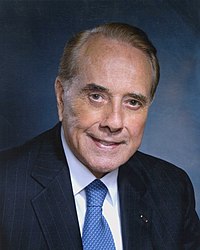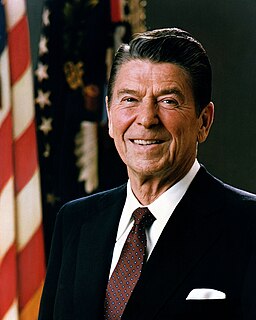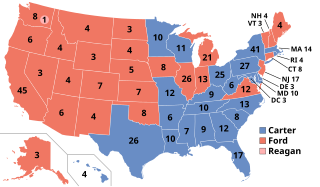
The 1976 United States presidential election was the 48th quadrennial presidential election. It was held on Tuesday, November 2, 1976. Democrat Jimmy Carter of Georgia defeated incumbent Republican President Gerald Ford from Michigan. Carter's win represented the lone Democratic victory in a presidential election held between 1968 and 1988.

The 1996 National Convention of the Republican Party of the United States convened at the San Diego Convention Center (SDCC) in San Diego, California, from August 12 to August 15, 1996. The convention nominated Bob Dole, former Senator from Kansas, for President and Jack Kemp, former Representative from suburban Buffalo, New York, and Secretary of Housing and Urban Development, for Vice President.
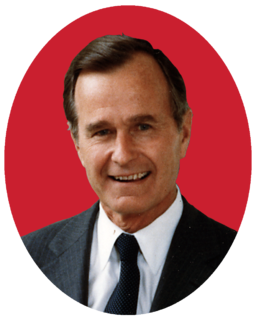
The 1988 Republican National Convention of the Republican Party of the United States was held in the Louisiana Superdome in New Orleans, Louisiana from August 15 to August 18, 1988. It was the second time that a major party held its convention in one of the five states known as the Deep South, coming on the heels of the 1988 Democratic National Convention, which was held in Atlanta, Georgia. Much of the impetus for holding the convention in the Superdome came from the Louisiana Republican National Committeewoman Virginia Martinez of New Orleans, who lobbied on behalf of her adopted home city as the convention site as a member of the RNC Executive Committee.

The 1968 National Convention of the Republican Party of the United States was held at the Miami Beach Convention Center in Miami Beach, Dade County, Florida, from August 5 to August 8, 1968, to select the party's nominee in the general election. It nominated former Vice President Richard M. Nixon for President and Maryland Governor Spiro T. Agnew for Vice President. It was the fourth time Nixon had been nominated on the Republican ticket as either its vice-presidential or presidential candidate (1960).

The 1980 National Convention of the Republican Party of the United States convened at Joe Louis Arena in Detroit, Michigan, from July 14 to July 17, 1980. The Republican National Convention nominated former Governor Ronald W. Reagan of California for President and former Representative George H. W. Bush of Texas for Vice President. Reagan, running on the theme "Let's Make America Great Again," stayed at the Detroit Plaza Hotel in the Renaissance Center, at the time the world's tallest hotel, and delivered his acceptance speech at Joe Louis Arena. It remains the only major party national political convention to have been held in Detroit.
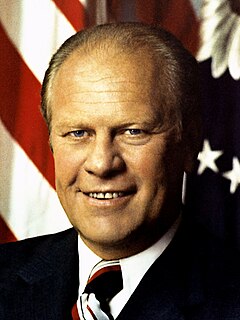
The 1976 Republican presidential primaries were a series of contests held to elect delegates to the 1976 Republican National Convention, held to nominate a candidate for President of the United States in the 1976 election.
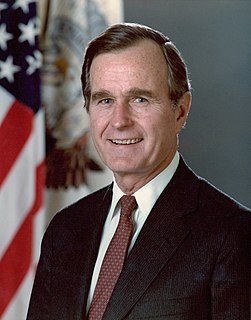
The 1988 Republican presidential primaries were the selection process that Republican voters used to choose their nominee for President of the United States in the 1988 U.S. presidential election. Incumbent Vice President George H.W. Bush was selected as the nominee through a series of primary elections and caucuses culminating in the 1988 Republican National Convention held from August 15 to August 18, 1988, in New Orleans, Louisiana.
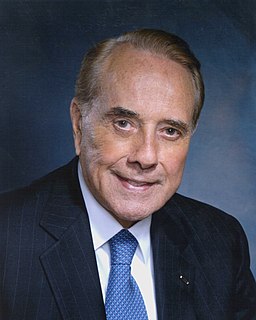
The 1996 Republican presidential primaries were the selection process by which voters of the Republican Party chose its nominee for President of the United States in the 1996 U.S. presidential election. Former Senator Bob Dole of Kansas, former Senate Majority Leader was selected as the nominee through a series of primary elections and caucuses culminating in the 1996 Republican National Convention held from August 12 to August 15, 1996, in San Diego, California.
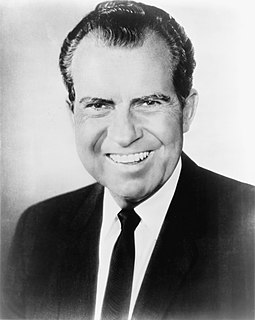
The 1968 Republican presidential primaries were the selection process by which voters of the Republican Party chose its nominee for President of the United States in the 1968 U.S. presidential election. Former Vice President Richard Nixon was selected as the nominee through a series of primary elections and caucuses culminating in the 1968 Republican National Convention held from August 5 to August 8, 1968, in Miami Beach, Florida.
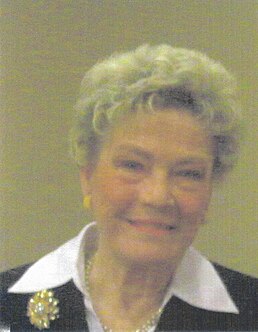
Barbara Ruth Wright Staff is a retired Republican political activist from Plano, Texas. She was co-chairman of her state's 1976 Ronald Reagan presidential primary campaign.

The 1976 United States elections was held on November 2, and elected the members of the 95th United States Congress. The Democratic Party won the presidential election and retained control of Congress.

The 1976 United States presidential election in Vermont took place on November 2, 1976, as part of the 1976 United States Presidential Election which was held throughout all fifty states and the District of Columbia. Voters chose three representatives, or electors to the Electoral College, who voted for president and vice president.

This article lists those who were potential candidates for the Republican nomination for Vice President of the United States in the 1988 election. Incumbent Vice President George H.W. Bush won the 1988 Republican nomination for President of the United States, and chose Indiana Senator Dan Quayle as his running mate. The selection of Quayle surprised many of Bush's closest advisers, who had expected Bush to pick a more well-known running mate. However, Bush adviser Roger Ailes helped convince Bush that Quayle would be able to effectively attack the Democratic presidential nominee, Michael Dukakis. Bush also liked Quayle's youth and felt that Quayle would make for a loyal vice president. The Bush-Quayle ticket ultimately defeated the Dukakis-Bentsen ticket in the 1988 election.

This article lists those who were potential candidates for the Republican nomination for Vice President of the United States in the 1996 election. Former Kansas Senator Bob Dole won the 1996 Republican nomination for President of the United States, and chose former New York Representative Jack Kemp as his running mate. Dole chose Kemp as his running mate in order to solidify support among the conservative wing of the Republican Party, despite the mutual personal distaste the two candidates had for each other. The Dole-Kemp ticket would lose the 1996 election to the Clinton-Gore ticket.

This article lists those who were potential candidates for the Republican nomination for Vice President of the United States in the 1980 election. Former California Governor Ronald Reagan won the 1980 Republican nomination for President of the United States, and chose former Texas Representative George H. W. Bush as his running mate. Reagan had considered naming former president Gerald Ford as his running mate, but after Ford and Reagan were unable to agree to be on the same ticket, Reagan turned to Bush, his primary rival for the 1980 Republican nomination. Though Bush had criticized Reagan's policies, Reagan chose Bush to help unify the party, and Bush agreed to be on the ticket and to support Reagan's platform. The Reagan-Bush ticket defeated the incumbent Democratic Carter-Mondale ticket, and in 1984 won re-election defeating the Mondale-Ferraro ticket. Bush was later elected president in his own right in 1988.
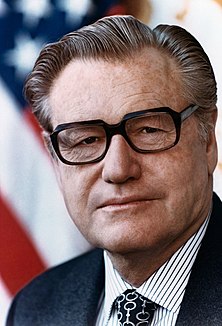
On August 9, 1974, Republican President Richard Nixon was forced to resign following the Watergate Scandal. Vice President Gerald Ford ascended to the presidency, leaving the office of vice president vacant. Under the terms of the 25th Amendment, a vice presidential vacancy is filled when the president nominates a candidate who is confirmed by both houses of Congress, which were controlled by the Democrats.
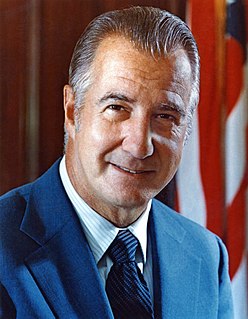
This article lists those who were potential candidates for the Republican nomination for Vice President of the United States in the 1968 election. After winning the Republican presidential nomination at the 1968 Republican National Convention, former Vice President Richard Nixon convened a series of meetings with close advisers and party leaders such as Strom Thurmond in order to choose his running mate. Nixon ultimately asked the convention to nominate Maryland Governor Spiro Agnew as his running mate. By a large margin, Agnew won the vice presidential nomination on the first ballot over Michigan Governor George W. Romney, who was supported by a faction of liberal Republicans. Nixon chose Agnew because he wanted a centrist who was broadly acceptable to the party, had experience with domestic issues, and appealed to Southern voters. The Nixon-Agnew ticket defeated the Humphrey-Muskie ticket, and also won re-election in 1972, defeating the McGovern-Shriver ticket. However, Agnew was forced to resign as Vice President in 1973 due to a controversy regarding his personal taxes.
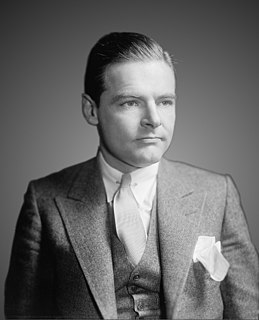
This article lists those who were potential candidates for the Republican nomination for Vice President of the United States in the 1960 election. After winning the Republican presidential nomination at the 1960 Republican National Convention, Vice President Richard Nixon needed to choose a running mate. President Dwight D. Eisenhower strongly supported UN Ambassador Henry Cabot Lodge Jr.. Though Lodge lacked charisma as a campaigner, his foreign policy experience and stature as ambassador made him an appealing candidate. However, Lodge was unpopular with the Republican right, who did not want a Northeastern moderate on the ticket. Nixon also strongly considered conservative Minnesota Representative Walter Judd and moderate Kentucky Senator Thruston Morton. After a closed session with Republican Party leaders, Nixon announced his choice of Lodge. The Republican convention ratified Nixon's choice of Lodge. The Nixon-Lodge ticket lost the 1960 election to the Democratic ticket of John F. Kennedy and Lyndon B. Johnson.
